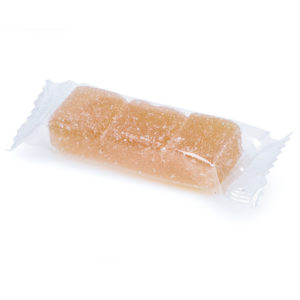Confectionery for endurance athletes
April 23, 2019 | DE STANDAARD
Selling confectionery to athletes does not immediately sound like a tight plan. The Belgian confectionery maker Confidas nevertheless sees a growth market in it. According to Aelterman, “our fruit jellies (pâtes de fruits) already come very close to the 2:1 glucose to fructose ratio which is perfect for athletes.”
FROM OUR EDITOR Dries De Smet
DRONGEN | You can smell the aroma of fresh jam in the production hall of Confidas. Yet, not a single jar is exported. With the same ingredients – fruit and sugar – pâtes de fruits are made here, or in other words fruit jellies. “Originally, fruit jellies had the same purpose as jam: to preserve fruit for the winter”, comments Aelterman (54), director at Confidas. Pâte de fruits has its origins in the Auvergne, a region in the south of France, where it has been produced for more than a thousand years.
Cycling races did not yet exist at that time nor plastic squeeze bottles. “If you take a look at the track the day after the Tour of Flanders for example, all you’ll find are empty wrappers of energy gels”, adds Aelterman.
8 million of sweets
Nowadays, fruit jellies – usually formed in shapes of fruit – are mainly sold in praline shops and bakeries. Confidas hopes however that these sweets will end up more often in the back pocket of the endurance athlete. “It is perfect if an endurance athlete needs a quick energy source. Our energy bars meet the same requirements as energy gels, but they are natural, easy to use and delicious.”
About half of the ingredients of fruit jellies are fruit, sugar, glucose syrup and pectin, a thickener made from apples or citrus fruit. Confidas is the only industrial producer of authentic fruit jellies in Belgium, with an annual production of 135.000 kilograms. That’s 8 million of sweets.
Two years ago, Aelterman took over the company founded in 1982, after a long career at Coca-Cola, the soft drink giant. He left the company as head of the European research department.

No apple
Is it a good idea to sell candy to athletes? “In fact, it is”, remarks Raf Van Dyck, sports dietician and affiliated with the faculty of medicine and health sciences at Ghent University. “In any case for people with the ambition to do endurance training. If you exercise for less than an hour and a half, it makes no sense. Sugar is not associated with health, but it is useless to eat an apple during high intensity exercises.
The “energy bars” produced by Confidas follow the original recipe used for the sweets that are sold in the praline shop or at the bakery. As Aelterman states, “we already come very close to the 2:1 glucose to fructose ratio which is perfect for athletes.”
Van Dyck confirms this. “If you exercise for up to two hours, you need 30 grams of carbohydrates per hour. For more than 2 hours, this corresponds to 60 grams. Large doses however can cause intestinal problems. It is important to have the right glucose to fructose ratio in order to prevent diarrhoea. A 2:1 ratio is optimal because we have twice as many glucose and fructose transporters.
“You will die without sugar”
Van Dyck warns that inappropriate marketing can lead to the fact that the candy bars are eaten by people who don’t need them. “For instance, people who go to the gym or work out for less than an hour.”
With a candy bar of 25 to 32 grams, a non-athlete will take too much sugar. The World Health Organization’s recommendation for sugar intake is 25 grams per day.
Aelterman emphasizes nonetheless that “everyone needs sugar”. “If you don’t eat sugar, you will die. Unfortunately, we are unaware of the many foods that contain added sugar. Thanks to the fruit jellies’ texture, you won’t eat too much of them. Unlike sweets containing gelatin, fruit jellies melt in your mouth making you feel saturated more quickly.”
Sweets and sports drinks
Van Dyck rode during the Easter holidays the Paris-Roubaix route with cycling friends. He had no fruit energy bars in his back pocket. “It may sound odd coming from a sports dietician, but I buy half a kilogram of candy at Colruyt, which costs me seven euros. To have the best glucose to fructose ratio, I use sports drinks.”
“We come very close to the 2:1 glucose to fructose ratio which is perfect for athletes.” | Luc Aelterman, director Confidas
Article by Editor Dries De Smet For De Standaard (read online)